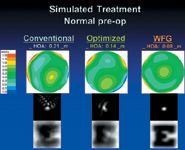Article
Computer-based model supports wavefront-guided LASIK for all eyes
Chicago?Evaluations of refractive surgery outcomes using a computer-based predictive model indicate that wavefront-guided LASIK results in better visual quality than optimized or conventional LASIK, regardless of the level of preoperative higher-order aberrations (HOAs), said Capt. Steven C. Schallhorn, MD, at the refractive surgery subspecialty day program during the American Academy of Ophthalmology annual meeting.

Outcomes for all three procedures were modeled for all-comers and three subgroups of eyes defined by preoperative HOA profiles. Those three subgroups consisted of normal eyes (HOA within ± 1 SD of the mean), normal eyes with negative spherical aberration, and highly aberrated eyes (>2 SD of the mean).

The predictive model
The predictive model was developed using preoperative and 1-month postoperative wavefront data from two large cohorts, one including 295 eyes that had undergone conventional LASIK and the second made up of 193 eyes treated with a wavefront-guided procedure. The wavefront analyses were based on a 6-mm pupil diameter and calculated Zernike terms through the sixth order.
Using the data from those 488 eyes, 10,000 random preoperative wavefront maps were generated using a Monte Carlo simulation. Then, the postoperative HOAs were modeled based on the distribution in change in each Zernike term. In the models, conventional LASIK was modeled to induce HOA with the same distribution, mean, and variability as the conventional dataset, wavefront-guided LASIK was modeled to do the same as the wavefront-guided dataset, and optimized LASIK was modeled to be neutral with respect to induction of spherical aberration, but that it would behave the same as conventional LASIK regarding other HOA terms.
The model also incorporated the important fact that the amount of change in HOA is related to the level of preoperative HOA.
"With wavefront-guided LASIK as well as with a conventional procedure, the more HOA present before surgery, the greater is the chance of reducing the induction of HOA or even reducing HOA compared with baseline," Dr. Schallhorn explained.
The results of the model showed that for all eyes, conventional LASIK induced 0.19 μm of HOA. Across the three HOA subgroups, the amount of HOA induced by the conventional procedure ranged from 0.11 to 0.20 μm. For the optimized procedure, induced HOA was 0.15 μm considering all eyes as well as in the normal eyes and the normal eyes with negative spherical aberration, while only 0.08 μm of HOA was induced in the highly aberrated eyes. Induced HOA after the wavefront-guided procedure ranged from 0.03 to 0.1 μm. It was greatest in the normal eyes and least in the highly aberrated eyes.
Newsletter
Don’t miss out—get Ophthalmology Times updates on the latest clinical advancements and expert interviews, straight to your inbox.




